

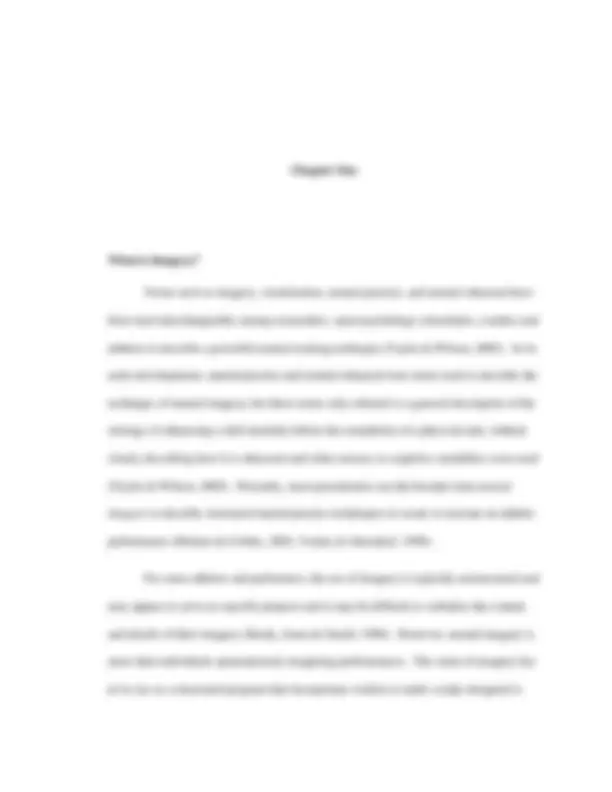
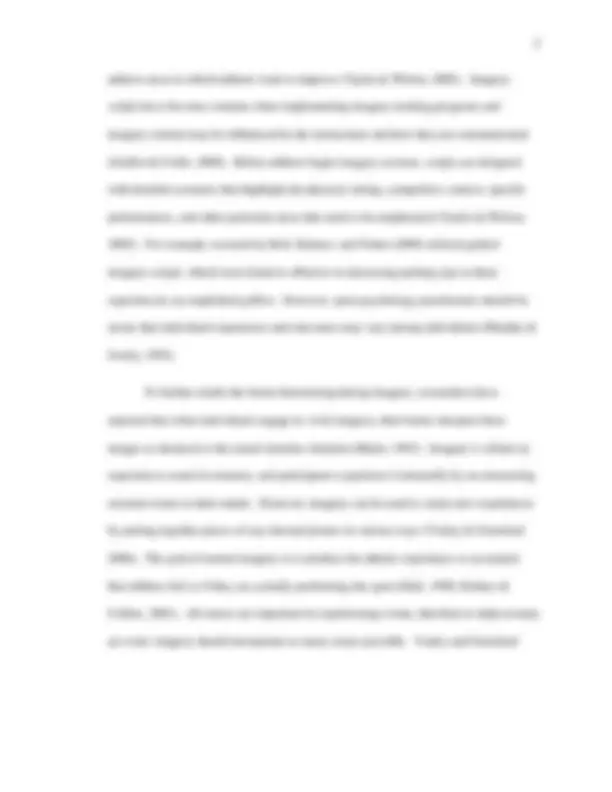
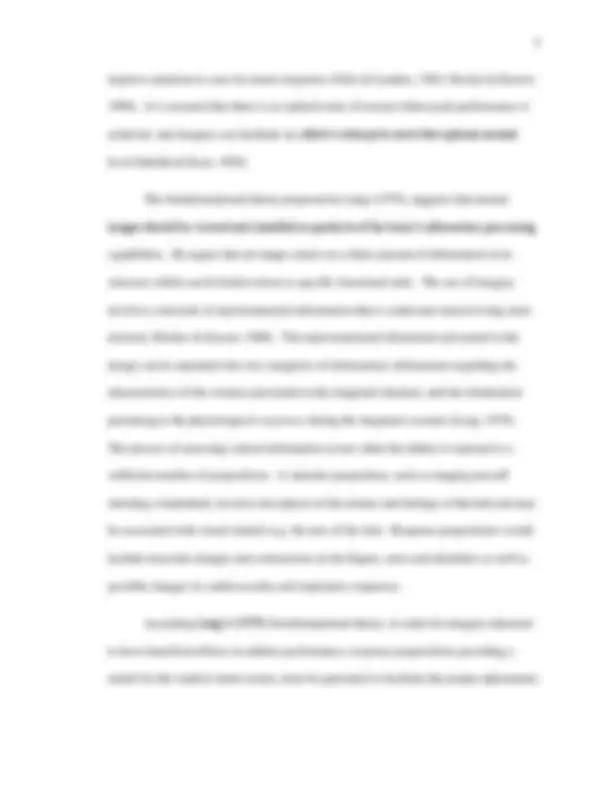
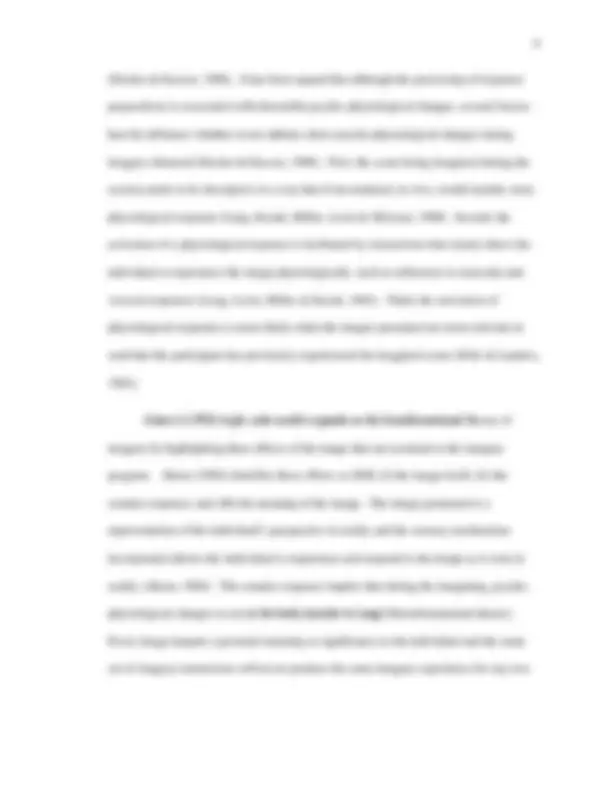
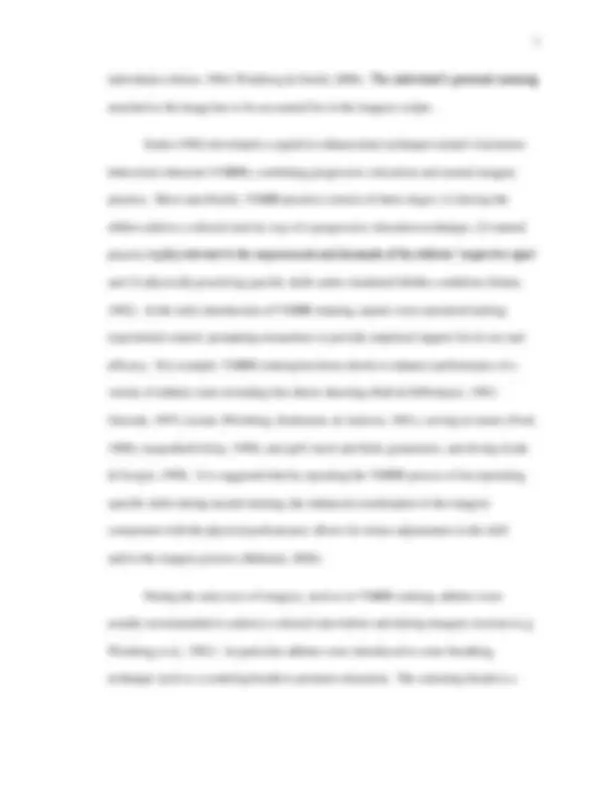
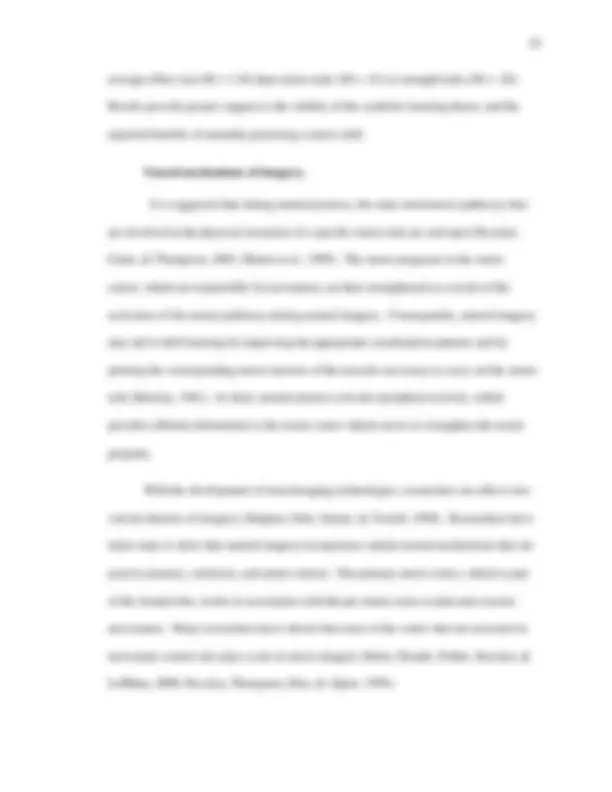
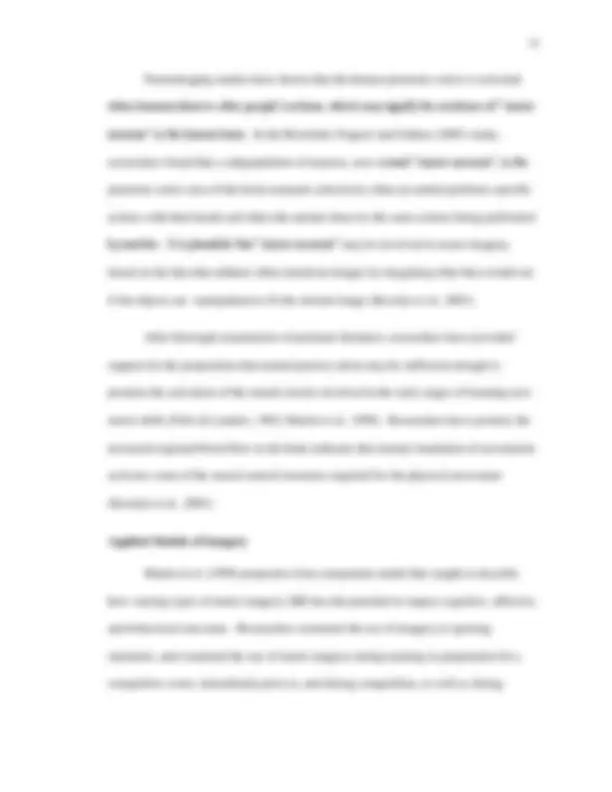
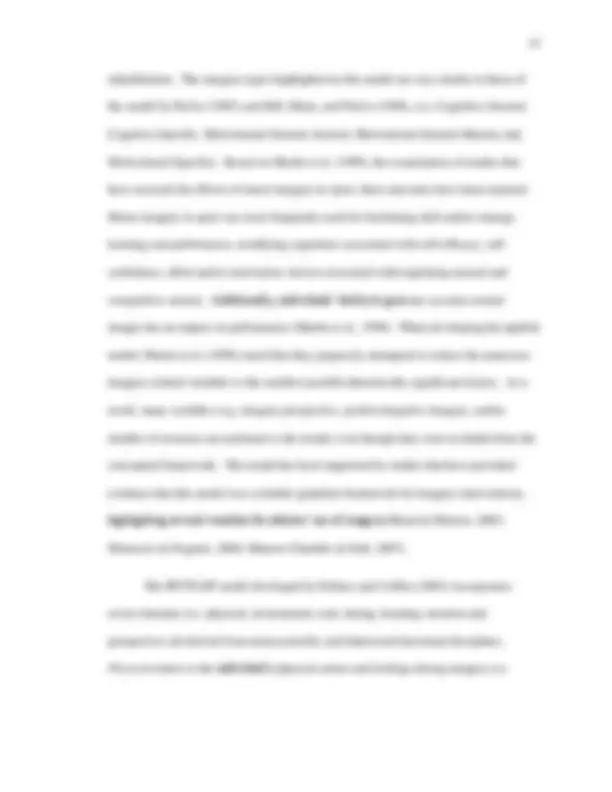
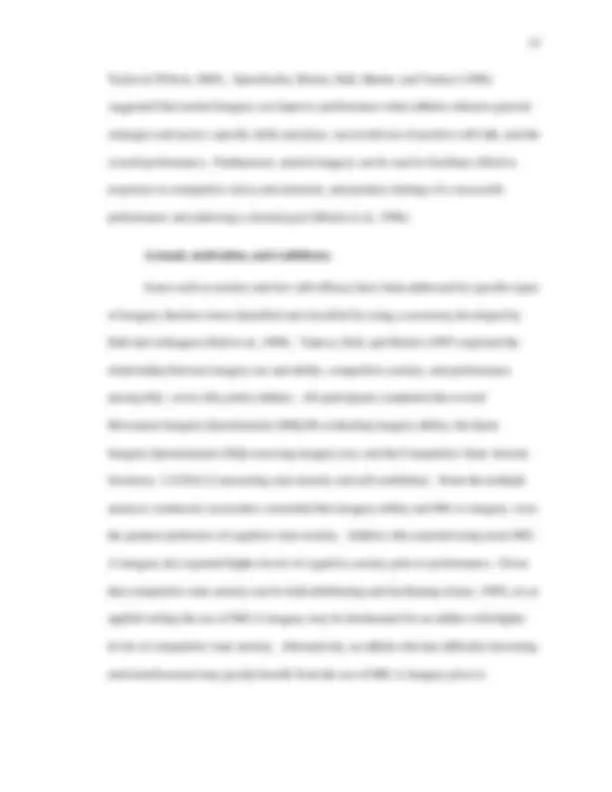
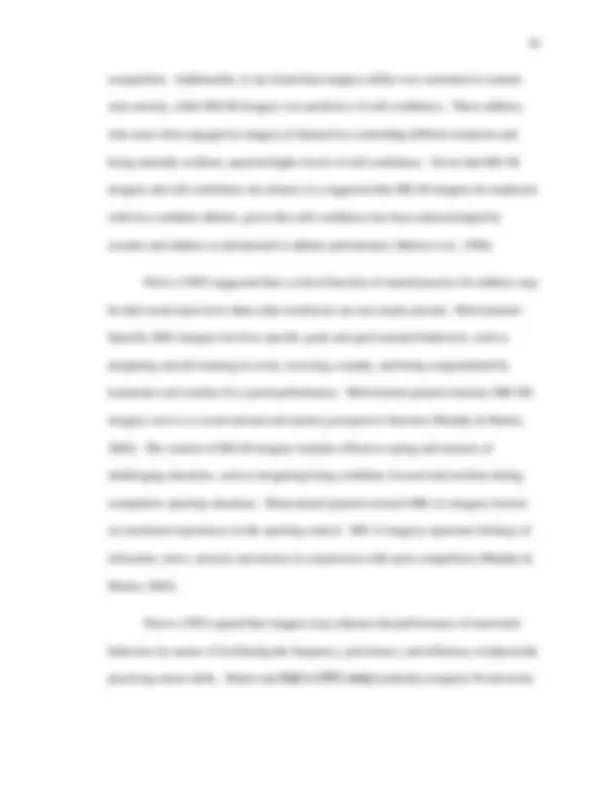
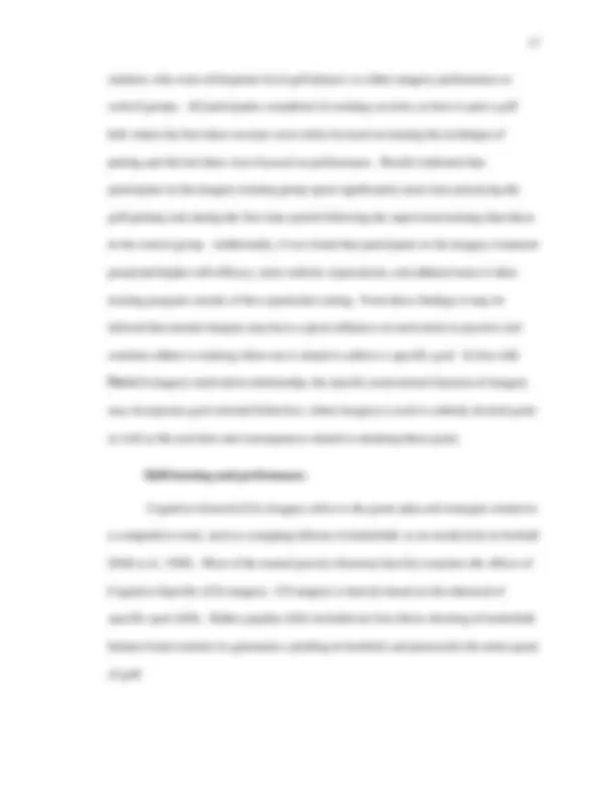
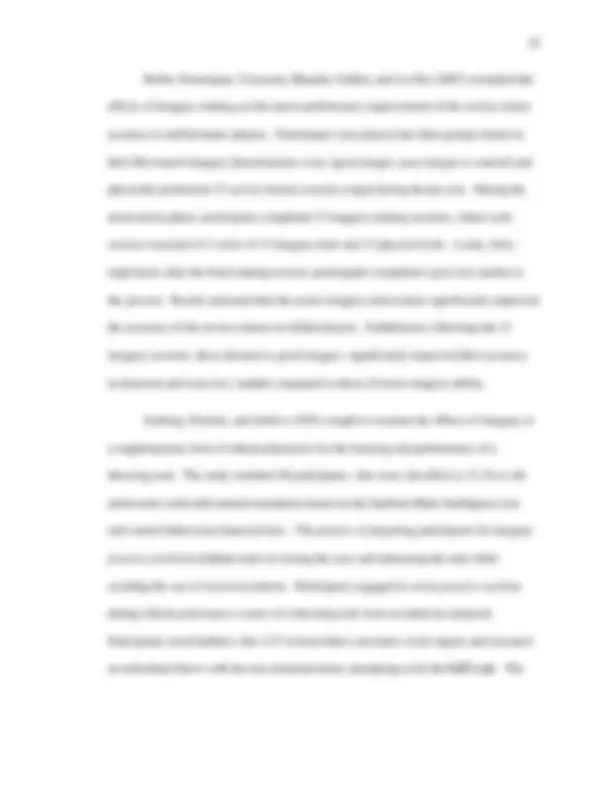
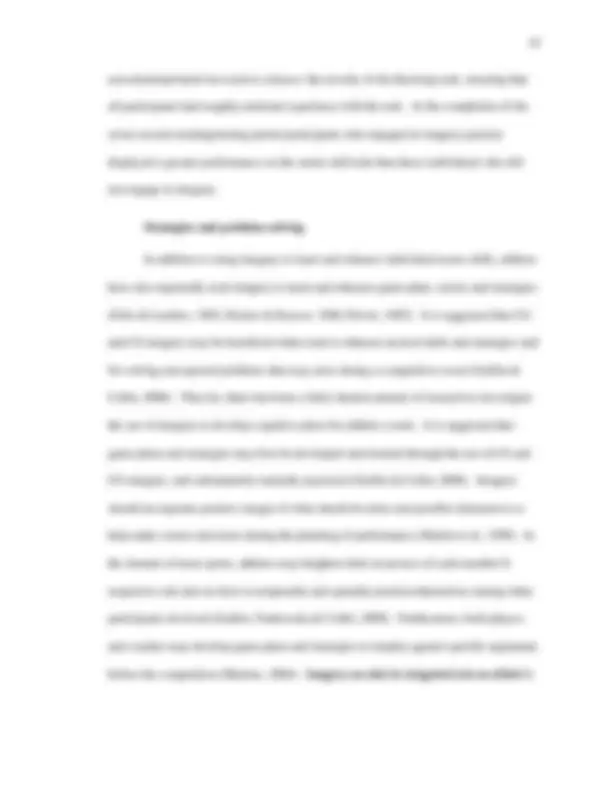
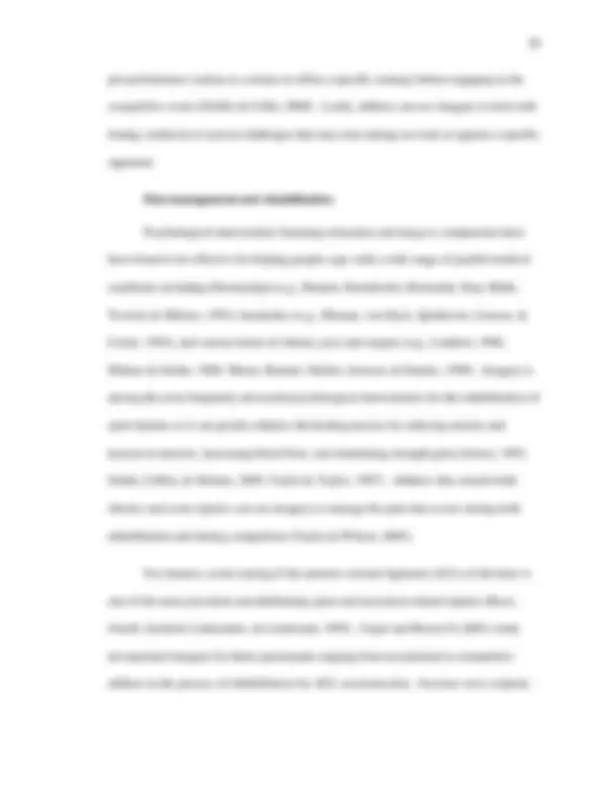
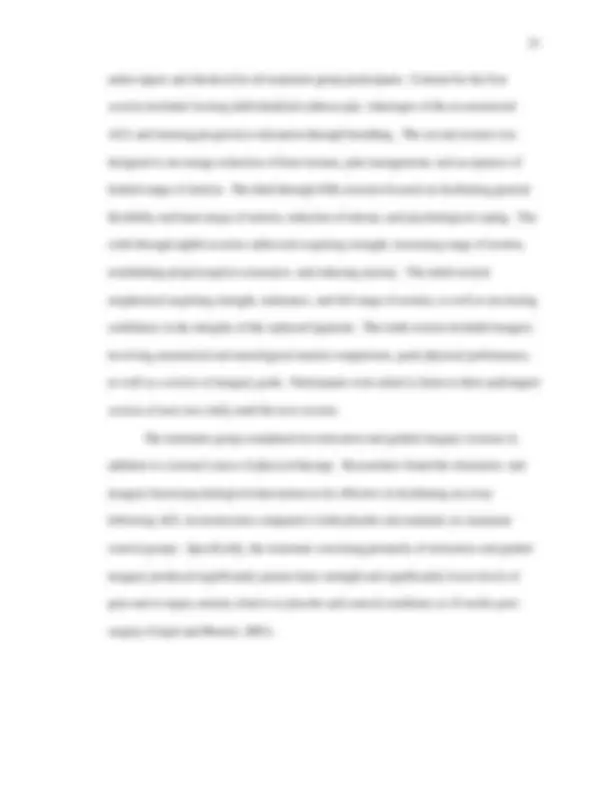
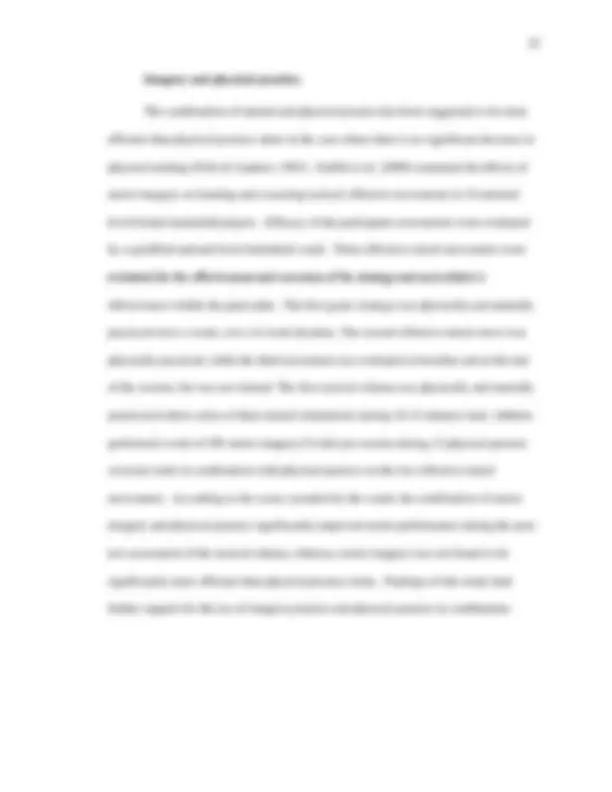
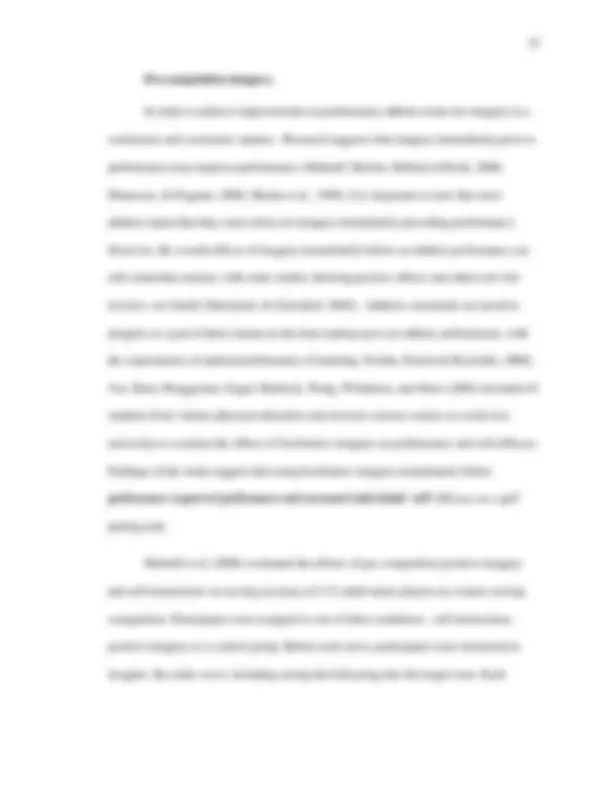
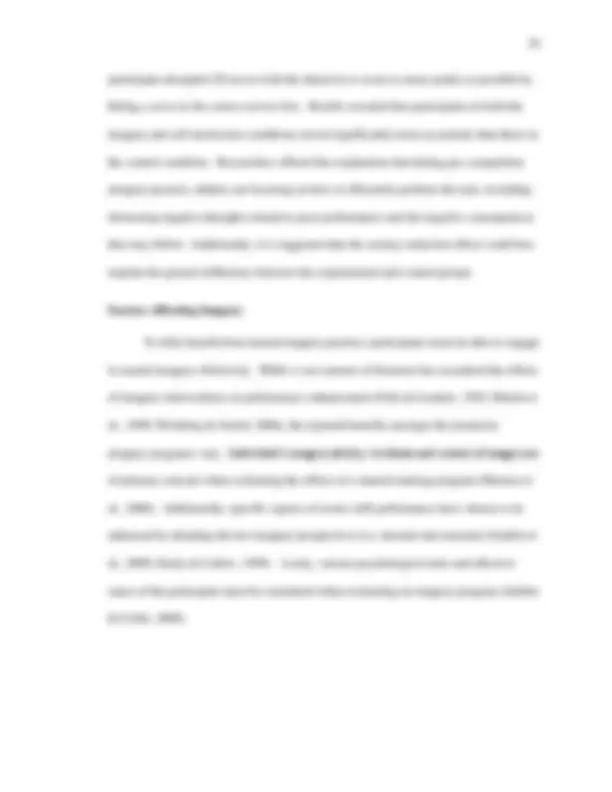
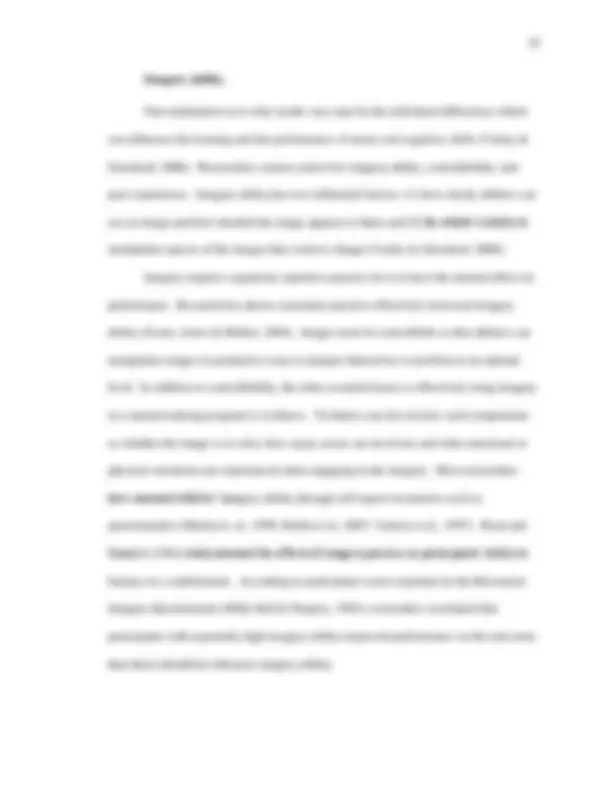
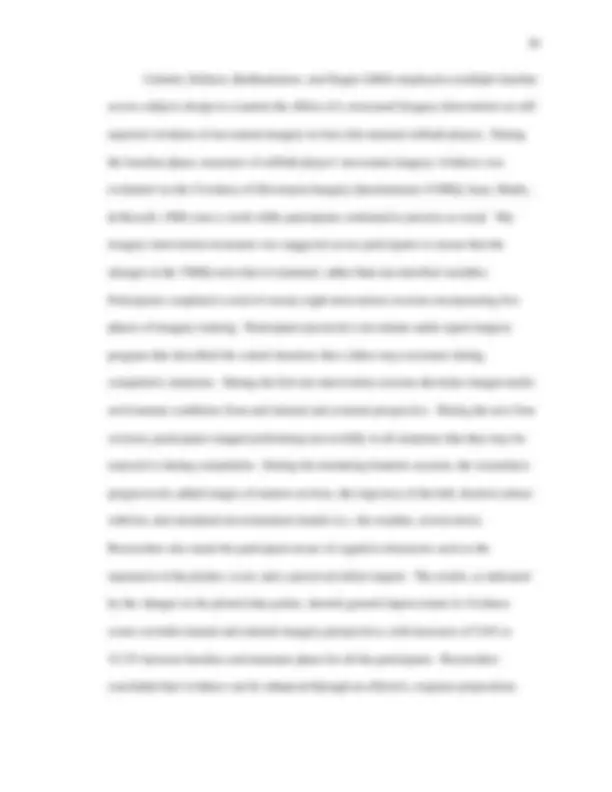
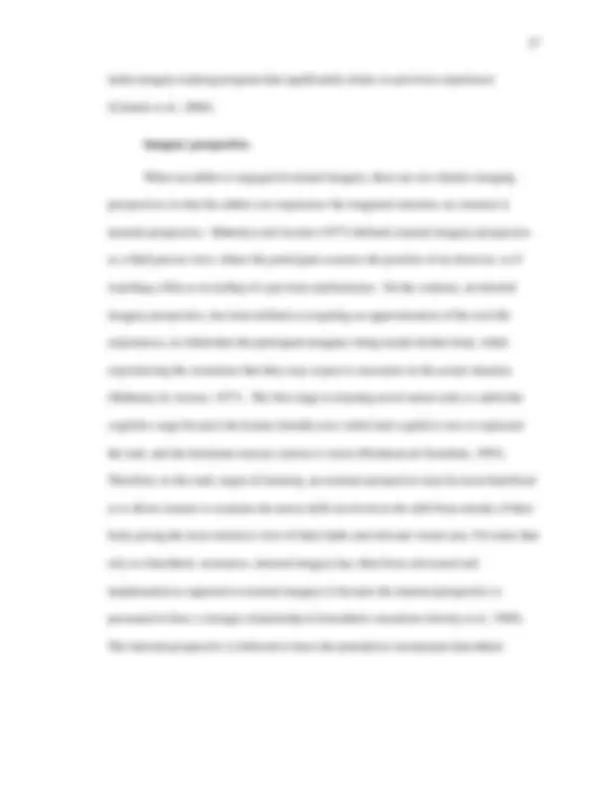
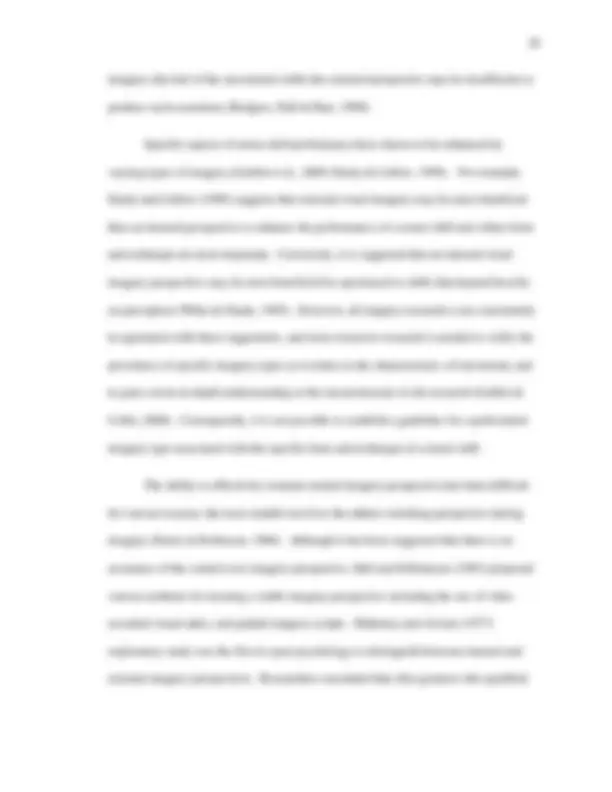
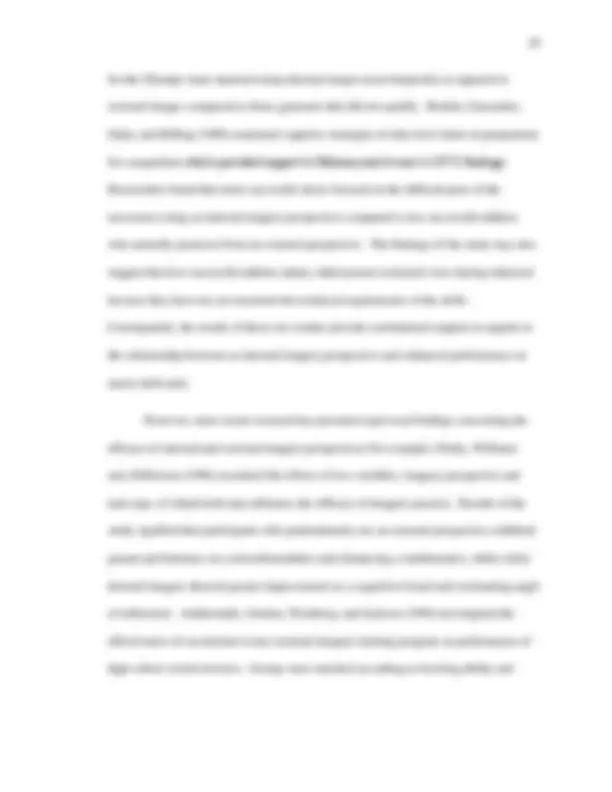

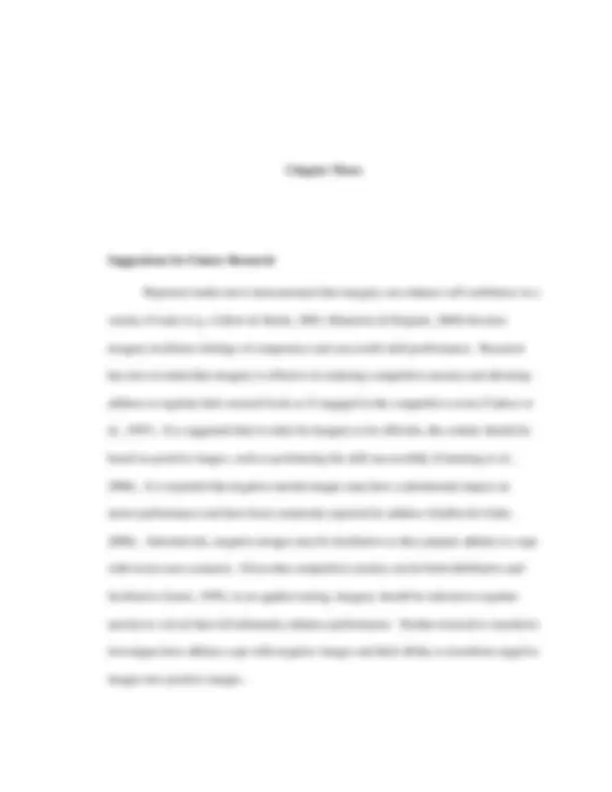
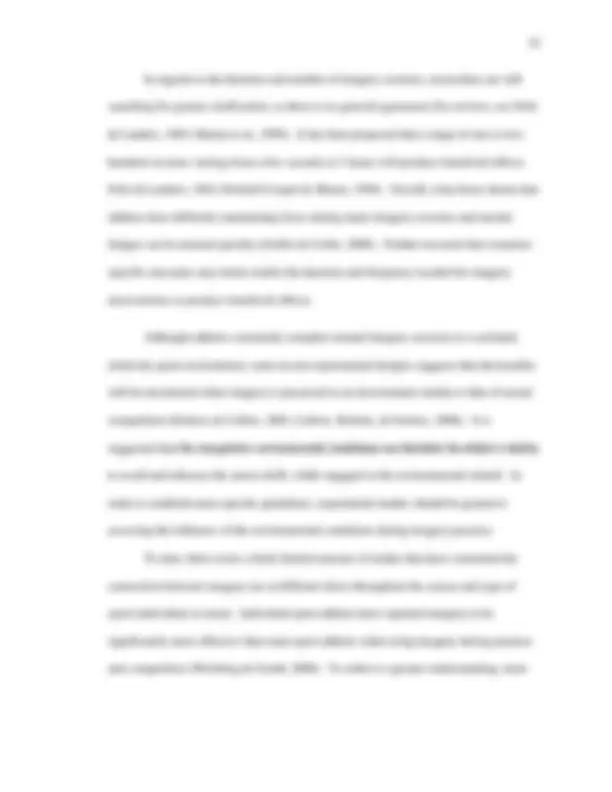
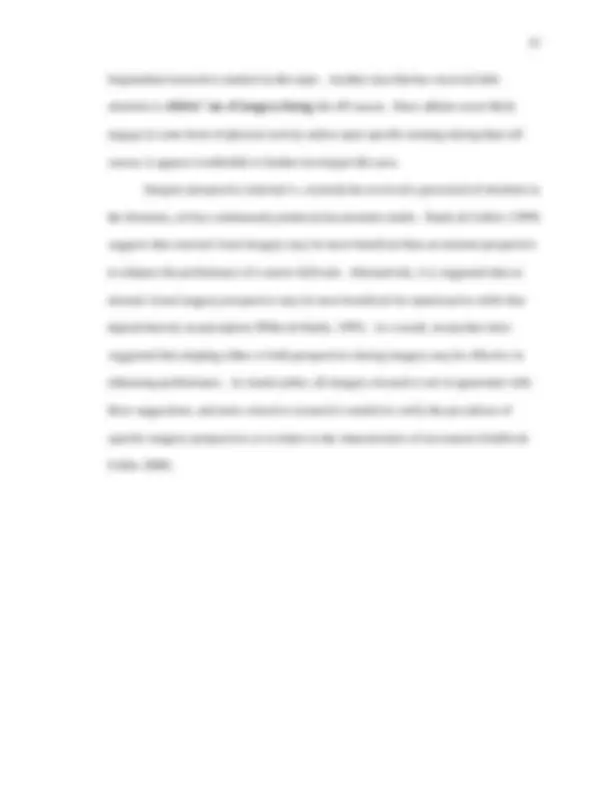
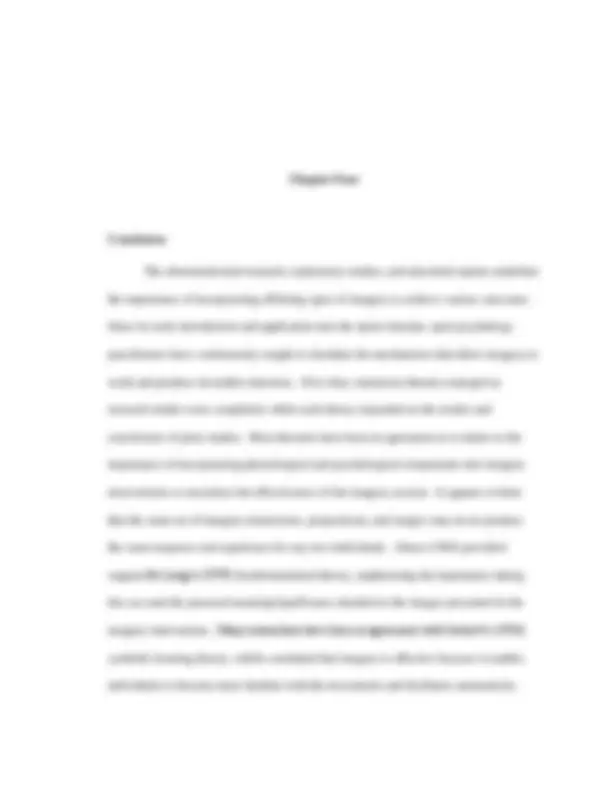
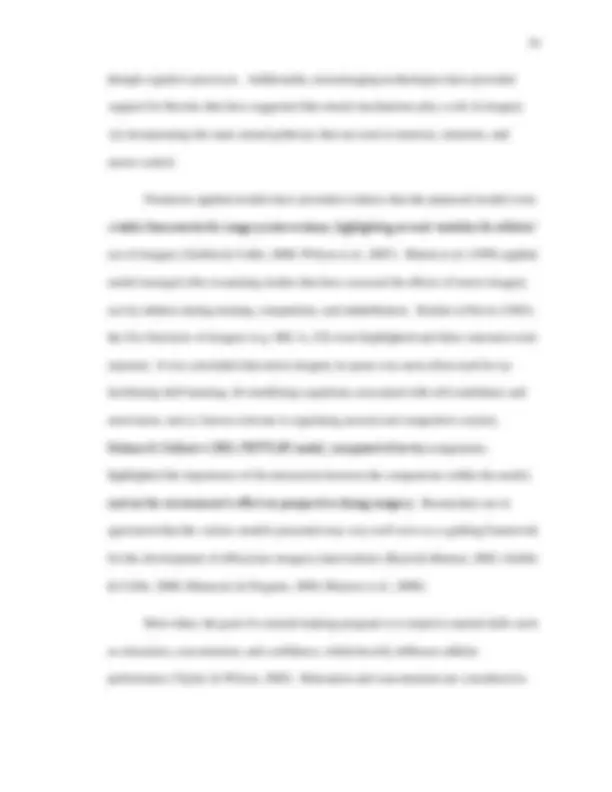
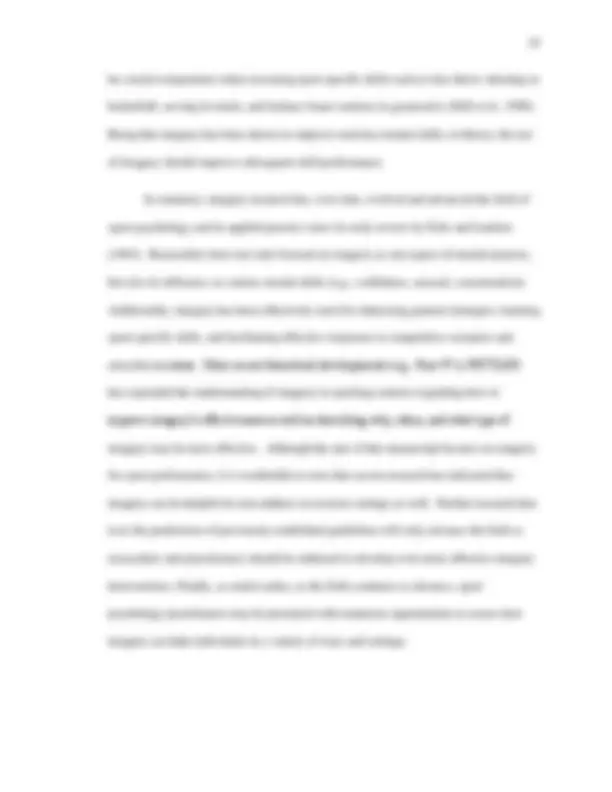
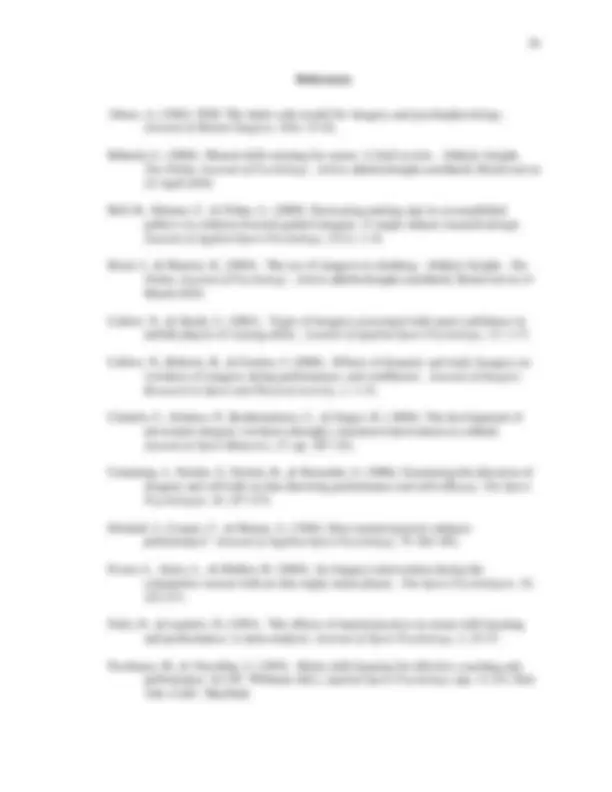
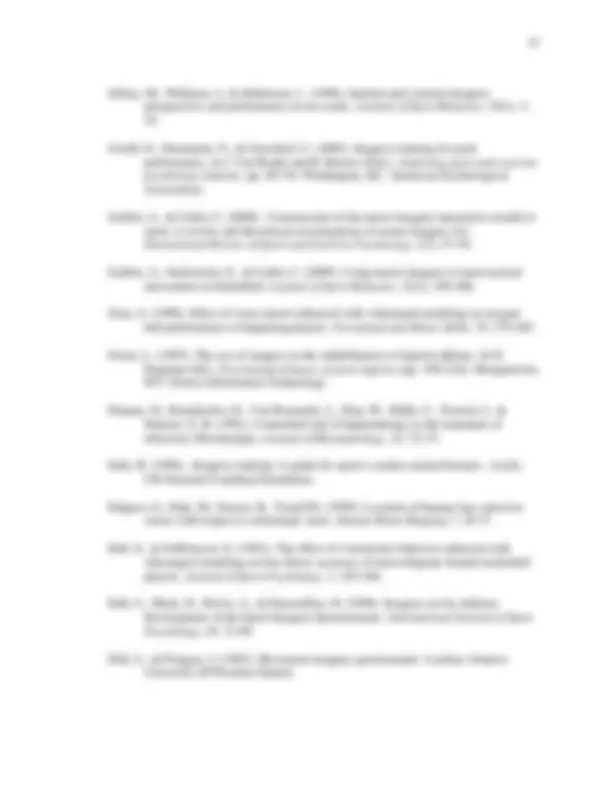
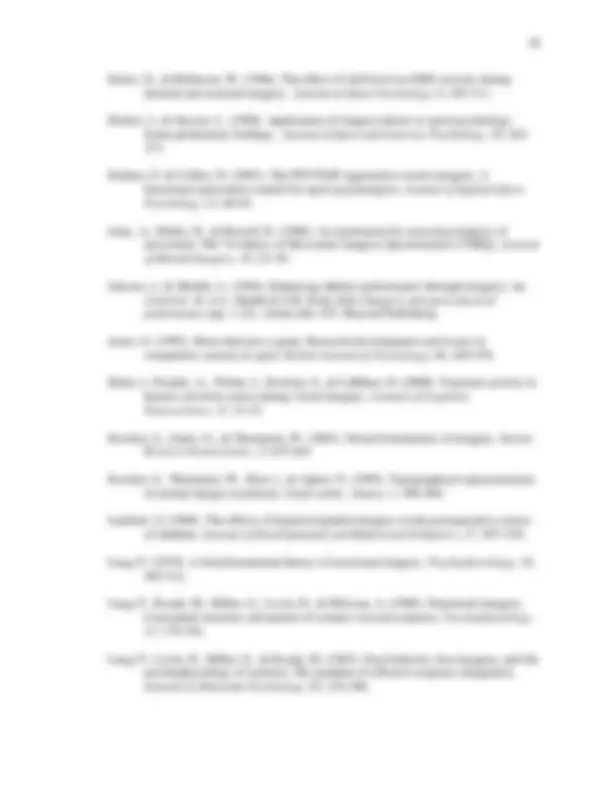
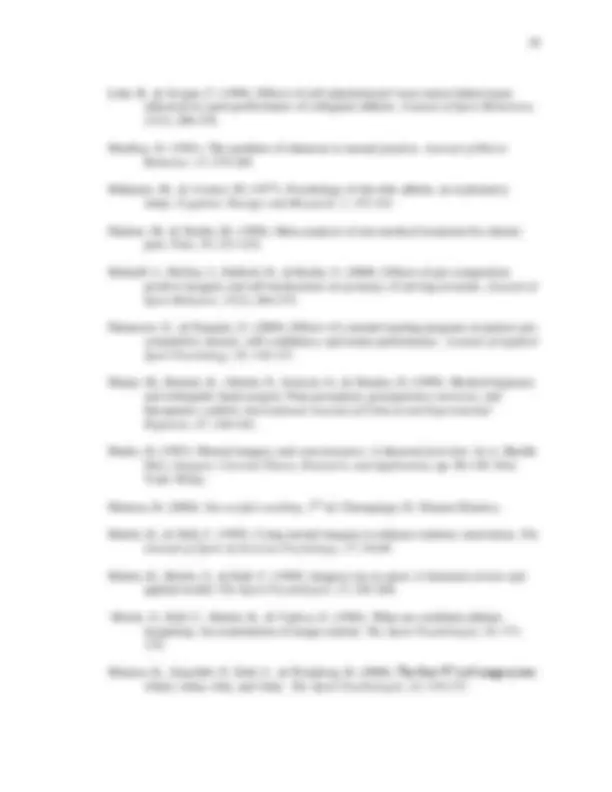

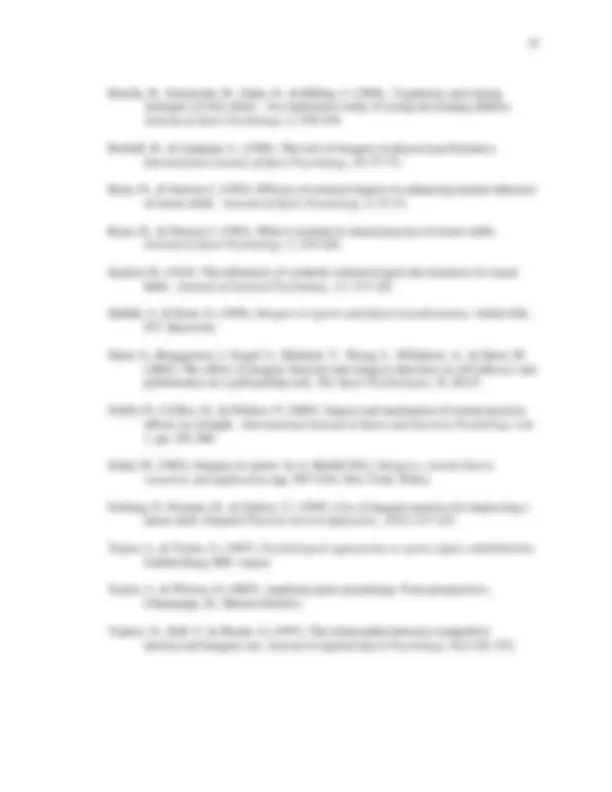
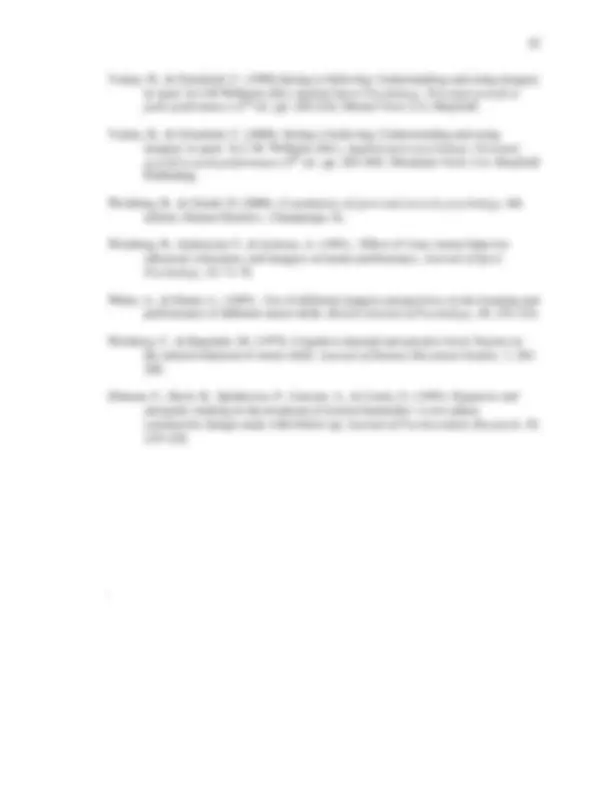



Study with the several resources on Docsity

Earn points by helping other students or get them with a premium plan


Prepare for your exams
Study with the several resources on Docsity

Earn points to download
Earn points by helping other students or get them with a premium plan
Community
Ask the community for help and clear up your study doubts
Discover the best universities in your country according to Docsity users
Free resources
Download our free guides on studying techniques, anxiety management strategies, and thesis advice from Docsity tutors
What is Imagery? Terms such as imagery, visualization, mental practice, and mental rehearsal have been used interchangeably among researchers, sport psychology ...
Typology: Exercises
1 / 47

This page cannot be seen from the preview
Don't miss anything!








































ii
TITLE: Imagery for Sport Performance: A Comprehensive Literature Review
STUDENT: Junayd Abdin DEGREE: Master of Arts COLLEGE: Applied Sciences and Technology DATE: July 2010 PAGES: 42 There exists ample evidence that mental imagery has the potential to improve motor performance. Extensive experiential and observational research, have led to the development of applied models in the field of sport psychology which seek to highlight some of the key components required to ensure its effective implementation. The following manuscript reviews theories and applied models that have been well- documented in the literature and is supported in its validity. Furthermore, research is reviewed examining the efficacy of mental imagery interventions within sports performance with an emphasis on (a) uses of imagery, and (b) factors affecting imagery. Discussion is aimed to accentuate the significance of implementing the most appropriate imagery interventions.
Chapter One
What is Imagery?
Terms such as imagery, visualization, mental practice, and mental rehearsal have been used interchangeably among researchers, sport psychology consultants, coaches and athletes to describe a powerful mental training technique (Taylor & Wilson, 2005). In its early developments, mental practice and mental rehearsal were terms used to describe the technique of mental imagery, but these terms only referred to a general description of the strategy of rehearsing a skill mentally before the completion of a physical task, without clearly describing how it is rehearsed and what sensory or cognitive modalities were used (Taylor & Wilson, 2005). Presently, most practitioners use the broader term mental imagery to describe structured mental practice techniques to create or recreate an athletic performance (Holmes & Collins, 2001; Vealey & Greenleaf, 1998).
For some athletes and performers, the use of imagery is typically unstructured and may appear to serve no specific purpose and it may be difficult to verbalize the content and details of their imagery (Hardy, Jones & Gould, 1996). However, mental imagery is more than individuals spontaneously imagining performances. The value of imagery lies in its use as a structured program that incorporates written or audio scripts designed to
address areas in which athletes want to improve (Taylor & Wilson, 2005). Imagery scripts have become common when implementing imagery training programs and imagery content may be influenced by the instructions and how they are communicated (Guillot & Collet, 2008). Before athletes begin imagery sessions, scripts are designed with detailed scenarios that highlight the physical setting, competitive context, specific performances, and other particular areas that need to be emphasized (Taylor & Wilson, 2005). For example, research by Bell, Skinner, and Fisher (2009) utilized guided imagery scripts, which were found to effective in decreasing putting yips in three experienced, accomplished golfers. However, sport psychology practitioners should be aware that individual experiences and outcomes may vary among individuals (Murphy & Jowdy, 1992).
To further clarify the brains functioning during imagery, researchers have reported that when individuals engage in vivid imagery, their brains interpret these images as identical to the actual stimulus situation (Marks, 1983). Imagery is reliant on experiences stored in memory, and participants experience it internally by reconstructing external events in their minds. However, imagery can be used to create new experiences by putting together pieces of any internal picture in various ways (Vealey & Greenleaf, 2006). The goal of mental imagery is to produce the athletic experience so accurately that athletes feel as if they are actually performing the sport (Hale, 1998; Holmes & Collins, 2001). All senses are important in experiencing events, therefore to help recreate an event, imagery should incorporate as many senses possible. Vealey and Greenleaf
Chapter Two
Review of Literature
The purpose of this chapter is to provide a critical overview of the literature pertaining to mental imagery and sport performance. This chapter contains a thorough examination of theories of imagery, applied models, the various uses of imagery and factors that ultimately affect the efficacy of an imagery intervention program.
Theories of Imagery
Sport psychology practitioners have sought to explain the mechanisms that allow imagery to work. Several theories exist, as there is no one single theory that can explain the effectiveness of imagery in its wholeness. The attention-arousal set theory seeks to explain imagery rehearsal while incorporating the cognitive and physiological components (Sheikh & Korn, 1994). The theory suggests that imagery is a technique in which athletes prepare for a motor performance both physiologically and psychologically. It is suggested that in the cognitive domain, imagery may help athletes focus on task relevant cues as opposed to irrelevant stimuli, which detracts from performance (Feltz & Landers, 1983). Through this mental technique, athletes also become aware of their physiological state, reduce inhibitions to the motor action, and
improve attention to cues for motor responses (Feltz & Landers, 1983; Hecker & Kaczor, 1988). It is assumed that there is an optimal state of arousal where peak performance is achieved, and imagery can facilitate an athlete’s attempt to reach that optimal arousal level (Sheikh & Korn, 1994).
The bioinformational theory proposed by Lang (1979), suggests that mental images should be viewed and classified as products of the brain’s information processing capabilities. He argues that an image carries on a finite amount of information in its structure which can be broken down to specific functional units. The use of imagery involves a network of representational information that is coded and stored in long-term memory (Hecker & Kaczor, 1988). The representational information presented in the image can be separated into two categories of information: information regarding the characteristics of the stimulus presented in the imagined situation, and the information pertaining to the physiological responses during the imagined scenario (Lang, 1979). The process of assessing critical information occurs when the athlete is exposed to a sufficient number of propositions. A stimulus proposition, such as imaging oneself shooting a basketball, involves descriptors of the texture and feelings of the ball and may be associated with visual stimuli (e.g. the nets of the rim). Response propositions would include muscular changes and contractions in the fingers, arms and shoulders as well as possible changes in cardiovascular and respiratory responses.
According Lang’s (1979) bioinformational theory, in order for imagery rehearsal to have beneficial effects on athletic performance, response propositions providing a model for the explicit motor action, must be generated to facilitate the proper adjustments
individuals (Ahsen, 1984; Weinberg & Gould, 2006). The individual’s personal meaning attached to the image has to be accounted for in the imagery scripts.
Suinn (1982) developed a cognitive enhancement technique termed visuomotor behavioral rehearsal (VMBR), combining progressive relaxation and mental imagery practice. More specifically, VMBR practice consists of three stages: (1) having the athlete achieve a relaxed state by way of a progressive relaxation technique, (2) mental practice highly relevant to the requirements and demands of the athletes’ respective sport and (3) physically practicing specific skills under simulated lifelike conditions (Suinn, 1982). In the early introduction of VMBR training, reports were anecdotal lacking experiential control, prompting researchers to provide empirical support for its use and efficacy. For example, VMBR training has been shown to enhance performance of a variety of athletic tasks including free-throw shooting (Hall & Erffemeyer, 1983; Onestak, 1997), karate (Weinberg, Seabourne, & Jackson, 1981), serving in tennis (Noel, 1980), racquetball (Gray, 1990), and golf, track and field, gymnastics, and diving (Lohr & Scogin, 1998). It is suggested that by repeating the VMBR process of incorporating specific skills during mental training, the enhanced coordination of the imagery component with the physical performance allows for minor adjustments in the skill and/or the imagery process (Behncke, 2004).
During the early uses of imagery, such as in VMBR training, athletes were usually recommended to achieve a relaxed state before and during imagery sessions (e.g. Weinberg et al., 1981). In particular athletes were introduced to some breathing technique such as a centering breath to promote relaxation. The centering breath is a
breathing technique intended to yield physical balance and allow the individual to mentally focus before attempting the task at hand (Nideffer, 1994). This technique involves a deep breath (from the stomach not chest), awareness of muscle tension, and a strong exhalation to relax the muscles, therefore promoting physical balance (Rogerson & Hrycaiko, 2002). The centering breath allows an individual to control physiological arousal and ignore irrelevant stimuli, ultimately improving concentration on the mental images (Nideffer & Sagal, 2006). However, data exists that suggests relaxation is not essential to imagery training, and actually has the potential to limit the benefits of imagery when the purpose of the intervention is to improve learning and performance of specific motor skills (Rushall & Lippman, 1998). It is believed that athletes should attain a level of arousal similar to that during the actual performance. Although athletes should feel comfortable before engaging in imagery, it is not required that imagery is directly associated with relaxation, especially in instances where the goal is to improve motor performance and adjust technical aspects. Alternatively the association with relaxation would be much stronger in imagery whose purpose is to achieve some motivational and/or self-confidence goals. It is reasonable to agree with Janssen and Sheikh (1994), who reported that relaxation may facilitate the generation of vivid mental images, but should not be maintained throughout the entire imagery session. In short, athletes may incorporate relaxation to reduce attention to irrelevant distractions just before an imagery session, but they should be able to regulate their arousal levels, similarly to how they would during actual performance (Guillot & Collet, 2008).
average effect size (M = 1.44) than motor tasks (M = .43) or strength tasks (M = .20). Results provide greater support to the validity of the symbolic learning theory and the reported benefits of mentally practicing a motor skill.
Neural mechanisms of imagery. It is suggested that during mental practice, the same neuromotor pathways that are involved in the physical execution of a specific motor task are activated (Kosslyn, Ganis, & Thompson, 2001; Martin et al., 1999). The motor programs in the motor cortex, which are responsible for movement, are then strengthened as a result of the activation of the neural pathways during mental imagery. Consequently, mental imagery may aid in skill learning by improving the appropriate coordination patterns and by priming the corresponding motor neurons of the muscles necessary to carry out the motor task (Mackay, 1981). In short, mental practice activates peripheral activity, which provides afferent information to the motor cortex which serves to strengthen the motor program.
With the development of neuroimaging technologies, researchers are able to test various theories of imagery (Halgren, Dale, Sereno , & Tootell, 1999). Researchers have taken steps to show that mental imagery incorporates similar neural mechanisms that are used in memory, emotions, and motor control. The primary motor cortex, which is part of the frontal lobe, works in association with the pre-motor areas to plan and execute movements. Many researchers have shown that areas of the cortex that are activated in movement control also play a role in motor imagery (Klein, Paradis, Poline, Kosslyn, & LeBihan, 2000; Kosslyn, Thompson, Kim, & Alpert, 1995).
Neuroimaging studies have shown that the human premotor cortex is activated when humans observe other people’s actions, which may signify the existence of ―mirror neurons‖ in the human brain. In the Rizzolatti, Fogassi and Gallese (2001) study, researchers found that a subpopulation of neurons, now termed ―mirror neurons‖, in the premotor cortex area of the brain responds selectively when an animal performs specific actions with their hands and when the animal observes the same actions being performed by another. It is plausible that ―mirror neurons‖ may be involved in motor imagery, based on the idea that athletes often transform images by imagining what they would see if the objects are manipulated to fit the desired image (Kosslyn et al., 2001).
After thorough examination of pertinent literature, researchers have provided support for the proposition that mental practice alone may be sufficient enough to promote the activation of the neural circuits involved in the early stages of learning new motor skills (Feltz & Landers, 1983; Martin et al., 1999). Researchers have posited, the increased regional blood flow in the brain indicates that mental simulation of movements activates some of the neural central structures required for the physical movement (Kosslyn et al., 2001).
Applied Models of Imagery
Martin et al. (1999) proposed a four-component model that sought to describe how varying types of motor imagery (MI) has the potential to impact cognitive, affective, and behavioral outcomes. Researchers examined the use of imagery in sporting situations, and examined the use of motor imagery during training in preparation for a competitive event, immediately prior to, and during competition, as well as during
increased HR, or feeling relaxed), while Environment refers to the inclusion of stimulus materials that help mimic motor performance. Timing signifies the importance of incorporating the imagery to mimic the actual performance duration. The task component includes the exact nature of imagery to be performed, the expertise level of the performer, as well as the imagery perspective. Learning relates to the use of imagery for the purpose of becoming familiar with new motor skills, and for the correction of some technical aspects required of the skill. Emotion relates to the individualistic incorporation of meaningful emotional components in the mental images presented in imagery. Lastly, perspective supports the use of an internally imagery perspective, while indicating the importance of an external perspective as it relates to the characteristics of the motor skill being performed.
The authors also ensured to highlight the importance of the interaction between the components within the model. The authors have identified crucial factors of imagery training (i.e. expertise level’s effect on learning new skills or the environment’s effect on perspective) that must be considered by the facilitator and the athlete to improve the efficacy of imagery intervention programs (Holmes & Collins, 2001). However, there were still specific aspects of imagery not incorporated (e.g. vividness, control, outcome of imagery, use of kinesthetic imagery, imagery for pain management, and imagery in the motor recovery processes). Specifically, authors did not address the role of imagery in promoting healing and pain management, as well as its effect on the motor recovery process following sporting injuries.
Munroe, Giacobbi, Hall, and Weinberg (2000) helped identify where, why, what type and when (Four W’s) athletes should use imagery. The authors used a qualitative approach based on a six stage model, which described how athletes may integrate imagery into their sporting context. Where differentiates between training and competitive environments, while when identifies the use of imagery during sporting activity as opposed to outside practice, in addition to immediately before, during and after a competitive event. Why refers to the use/purpose of the imagery (i.e. cognitive or motivational functions). The length and frequency, nature, surroundings, effectiveness and controllability refers to what the athlete should imagine. The last two stages of the model include many other essential components, one being the type of imagery (e.g. auditory, kinesthetic, olfactory), the imagery perspective (internal vs. external visual imagery), or the inclusion positive and negative images. In the domain of competitive sporting situations, this model may very well serve as a guide for the development of effective imagery interventions (Guillot & Collet, 2008). The major strength of the model emerged from its qualitative design in that a number of key components of imagery use emerged from the questionnaires proposed by the authors. However, the list of components is not extensive and does not consider the specificity of each component as it relates to the athletes’ expected outcomes. Furthermore, the model did not account for the effects of imagery during the injury rehabilitation process.
Uses of Imagery
It has been proposed that mental imagery enhances performance by improving key mental factors that heavily influence athletic performance (Callow & Hardy, 2001;
competition. Additionally, it was found that imagery ability was correlated to somatic state anxiety, while MG-M imagery was predictive of self-confidence. Those athletes, who more often engaged in imagery of themselves controlling difficult situations and being mentally resilient, reported higher levels of self-confidence. Given that MG-M imagery and self-confidence are related, it is suggested that MG-M imagery be employed with less confident athletes, given that self-confidence has been acknowledged by coaches and athletes as detrimental to athletic performance (Moritz et al., 1996).
Paivio (1985) suggested that a critical function of mental practice for athletes may be their motivation level when other reinforcers are not clearly present. Motivational– Specific (MS) imagery involves specific goals and goal-oriented behaviors, such as imagining oneself winning an event, receiving a trophy, and being congratulated by teammates and coaches for a good performance. Motivational general-mastery (MG-M) imagery serves as a motivational and mastery perspective function (Murphy & Martin, 2002). The content of MG-M imagery includes effective coping and mastery of challenging situations, such as imagining being confident, focused and resilient during competitive sporting situations. Motivational general-arousal (MG-A) imagery focuses on emotional experiences in the sporting context. MG-A imagery represents feelings of relaxation, stress, arousal, and anxiety in conjunction with sport competition (Murphy & Martin, 2002).
Paivio (1985) argued that imagery may enhance the performance of motivated behaviors by means of facilitating the frequency, persistence, and efficiency of physically practicing motor skills. Martin and Hall’s (1995) study randomly assigned 39 university
students, who were all beginner level golf players, to either imagery performance or control groups. All participants completed six training sessions on how to putt a golf ball, where the first three sessions were solely focused on training the technique of putting and the last three were focused on performance. Results indicated that participants in the imagery training group spent significantly more time practicing the golf-putting task during the free-time period following the supervised training than those in the control group. Additionally, it was found that participants in the imagery treatment group had higher self-efficacy, more realistic expectations, and adhered more to their training program outside of the experiential setting. From these findings it may be inferred that mental imagery may have a great influence on motivation to practice and continue adhere to training when one is aimed to achieve a specific goal. In line with Paivio’s imagery-motivation relationship, the specific motivational function of imagery may incorporate goal-oriented behaviors, where imagery is used to embody desired goals as well as the activities and consequences related to attaining those goals.
Skill learning and performance. Cognitive-General (CG) imagery refers to the game-plan and strategies related to a competitive event, such as a trapping defense in basketball, or an onside kick in football (Hall et al., 1998). Most of the mental practice literature heavily examines the effects of Cognitive-Specific (CS) imagery. CS imagery is heavily based on the rehearsal of specific sport skills. Rather popular skills included are free-throw shooting in basketball, balance beam routines in gymnastics, pitching in baseball, and practically the entire game of golf.